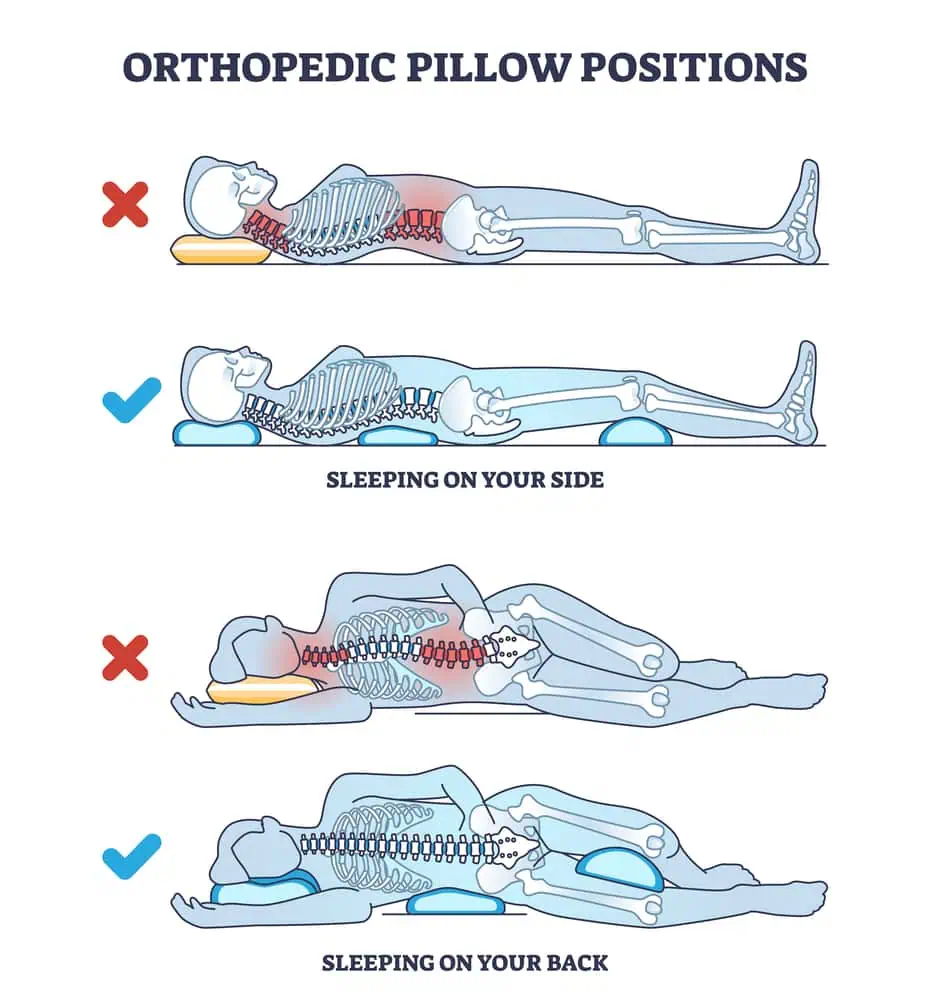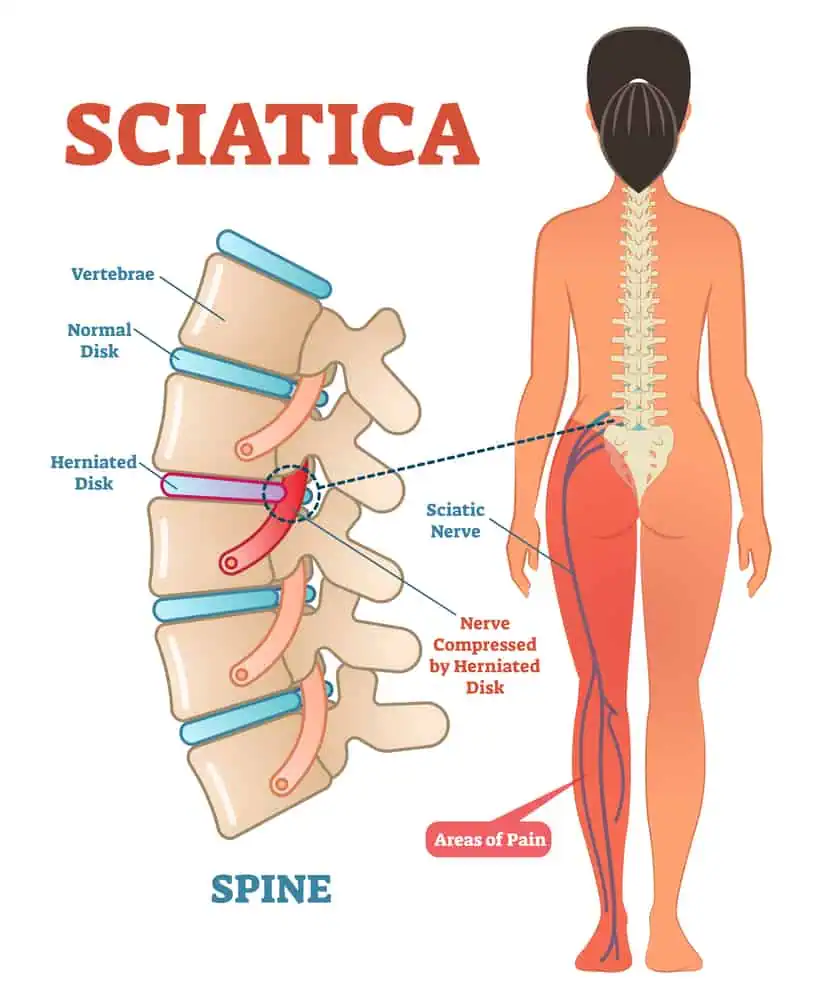Imagine a pain that begins in your lower back and travels down your leg, intensifying as the sun sets and the night blankets the sky. This is a reality for many experiencing sciatica, a condition that can make “sciatica worse at night”, transforming peaceful nights into a throbbing nightmare. But fear not, for the darkness holds solutions as well as challenges. This journey through the night will illuminate effective strategies to manage and alleviate your sciatica pain, turning the nocturnal ordeal into a restful slumber.
Key Takeaways
- Sciatica pain can be managed by experimenting with optimal sleep positions, using supportive mattresses and pillows, engaging in pre-bedtime stretching routines, taking medications or natural remedies and making lifestyle changes.
- The importance of proper mattress support for maintaining spinal alignment is key to relieving sciatica pain at night.
- When self care measures do not help reduce the discomfort from sciatica flare ups it is important to seek professional help from specialists such as orthopedists or physical therapists.

Why is Sciatica Worse at Night
Experiencing a spike in sciatica pain at night can feel like a cruel twist of fate. The very time meant for rest and recovery becomes a period of discomfort and agony. This intensification is largely due to increased pressure on the sciatic nerve, fewer distractions, and discomfort in sleep positions. The sciatic nerve, a mixed nerve that runs from the lumbar spine, can become a conduit for sciatic nerve pain when conditions such as degenerative disc disease and disc herniation put pressure on it.
The lumbar spine, the starting point of the sciatic nerve, contains intervertebral discs and nearby structures that can degrade or herniate over time, potentially leading to lumbar spinal stenosis. When this happens, they press against the sciatic nerve, creating a cascade of pain that can make sciatica pain worse at night. This is where the pain worse at night phenomenon happens. The discomfort can be further aggravated by certain sleeping positions, which can put additional pressure on the already beleaguered nerve.
But don’t let the daunting night time sky intimidate you. Understanding the reasons behind this nocturnal pain escalation can be a beacon of hope, guiding you towards effective solutions. Addressing the root cause and employing proactive treatment strategies can help you regain control over sciatica pain and restore your peaceful nights.
Optimal Sleep Positions for Alleviating Sciatica Pain

Sleep positions play an instrumental role in either alleviating or exacerbating sciatica pain. The key lies in identifying and adopting positions that reduce pressure on the sciatic nerve, thereby offering pain relief and improving sleep quality.
Side sleepers can alleviate sciatica pain by bending the upper knee and inserting a body pillow between the knees. This position helps maintain alignment of the spine, hips, and pelvis, offering sciatica pain relief and a good night’s sleep.
For those who feel pain predominantly in the back, the fetal position might be your ticket to dreamland. This position can significantly alleviate discomfort, making sleep with sciatica less of a battle and more of a restful retreat. If finding comfort while sleeping on your back feels like a daunting challenge, consider placing a pillow under the knees. This additional support can help you fall asleep more comfortably and reduce pain.
Bear in mind, a one-size-fits-all solution does not exist when it comes to sleeping positions. The best sleeping position for you is the one that offers the utmost comfort and pain relief. It might take a little bit of trial and error, but finding that optimal sleep position can make all the difference in managing your sciatica pain. Some common sleeping positions to try are:
- Sleeping on your back with a pillow under your knees
- Sleeping on your side with a pillow between your knees
- Sleeping in the fetal position
- Sleeping on your stomach with a pillow under your hips
Experiment with these positions and see which one works best for you.

The Importance of Proper Mattress and Pillow Support
Recall the tale of the princess and the pea? Just as the tiny pea disrupted the princess’s sleep, an unsupportive mattress or improperly placed pillow can exacerbate sciatica pain. Choosing a supportive mattress and using pillows strategically can help maintain spinal alignment and reduce pressure on the sciatic nerve, thus easing night-time pain.
A supportive mattress acts as your initial defense against sciatica pain. It provides proper spine support, essential for relieving sciatica pain caused by conditions like a herniated disc. It’s preferable to choose a medium-firm mattress that enhances sleep quality and reduces the likelihood of experiencing back pain. Alongside a good mattress, a high-quality neck pillow can help maintain alignment of the cervical spine, reducing lower back pain in the long run.
But it’s not just about having a good mattress and pillow. Their placement matters too. Using a small pillow or throw under the tailbone can provide stability and support to the lower back, particularly when sleeping on the back. The goal is to create an environment conducive to comfort and proper alignment, where sciatica pain can be effectively managed.
Pre-Bedtime Routines to Ease Sciatica Pain
The path to a good night’s sleep without pain starts long before you hit the bed. Establishing a pre-bedtime routine can help relax muscles, release endorphins, and reduce sciatica pain before you sleep. It’s like setting the stage for a restful night, creating the perfect conditions for your body to rest and recover.
Adopting a regimen that includes gentle stretching, warm baths, and massages can contribute to muscle relaxation and relieve sciatica pain. Gentle stretches before bedtime, for example, can alleviate discomfort associated with sciatic pain during sleep. The warm embrace of a bath can facilitate the movement of a compressed nerve in the lower back and body, offering pain relief conducive to relaxation and improved sleep.
In addition to stretches and warm baths, massages can also be beneficial in alleviating sciatica symptoms, particularly before bedtime. Techniques like Palm & Thumb Sciatica Massage and Knuckle Pressure Sciatica Massage can be performed at home and help ease the stress of the day, prepping your body for a restful night.

Medications and Natural Remedies for Nighttime Sciatica Relief
Alongside lifestyle adjustments and sleep strategies, medications and natural remedies can offer additional relief, especially during nighttime. Over-the-counter medications like nonsteroidal anti-inflammatory drugs (NSAIDs) such as ibuprofen and aspirin, along with creams containing lidocaine or capsaicin, can effectively alleviate sciatica pain.
Prescribed drugs, including acetaminophen (Tylenol), NSAIDs like naproxen (Aleve) and ibuprofen, and medications like cyclobenzaprine, can also provide relief from nighttime sciatica pain. However, it’s important to remember that medications should be taken under the guidance of a healthcare provider, as everyone’s body responds differently to different drugs.
Natural remedies, like pain-relief patches, can also be a game-changer in managing sciatica pain. These patches deliver medication gradually through the skin to provide targeted relief, reducing pain by up to 40% compared to pre-application levels. They can be particularly effective in providing continuous relief during sleep, making the night less about managing pain and more about rest and recovery.

Lifestyle Changes to Prevent Sciatica Flare-Ups
Although managing sciatica pain is vital, averting flare-ups is of equal importance. Lifestyle changes, such as maintaining a healthy weight, practicing good posture, and engaging in regular exercise, can have a profound impact on your spinal health and help prevent sciatica flare-ups.
Extra body weight can put additional strain on the sciatic nerve, causing or exacerbating sciatica pain. Shedding those extra pounds through a balanced diet and regular exercise can alleviate symptoms and decrease the risk of flare-ups. Similarly, practicing good posture, both when sitting and standing, can ensure proper alignment of the spine, minimizing pressure on the sciatic nerve.
Regular exercise, particularly stretches and exercises targeting the lower back and affected leg muscles, can strengthen the surrounding muscles, providing improved support to the spine and reducing the likelihood of future flare-ups. It’s not about immediate results, but consistent efforts, leading to a healthier spine and a happier you.

When to Seek Professional Help for Sciatica Pain
Although self-care measures and home remedies can effectively manage sciatica pain, professional help is required at times. If your sciatica pain continues or intensifies despite trying various strategies, seeking professional help is a crucial step in your journey towards pain-free nights.
Persistent nighttime sciatica pain can be an indicator that your body needs more than just home remedies. It’s a signal that the underlying issue needs to be addressed by a healthcare provider who can diagnose the root cause and develop a personalized treatment plan.
Specialists like:
- orthopedists
- neurologists
- chiropractors
- physical therapists
have the expertise to provide treatment for sciatica. They can offer valuable guidance on how to improve sleep, manage pain, and enhance overall spinal health. So don’t hesitate to seek help when needed. You’re not alone in this journey, and professional help is just a call away.
Summary
Navigating the complexities of sciatica pain, particularly at night, can feel like traversing a labyrinth. But with the right strategies and understanding, you can turn this daunting journey into a path towards relief and restful nights.
From understanding why sciatica pain intensifies at night, to adopting optimal sleep positions, choosing the right mattress and pillow, establishing pre-bedtime routines, using medications and natural remedies, to making lifestyle changes and knowing when to seek professional help – each step brings you closer to reclaiming your peaceful nights.
Remember, while challenges may arise, you have the power to manage your sciatica pain and improve your quality of life. So take charge of your health, apply these strategies, and turn the tide against sciatica. The night may be dark, but it’s also filled with hope, and this hope can guide you towards a future where sciatica pain no longer rules your nights.

Frequently Asked Questions
What helps sciatic pain at night?
To help ease sciatic pain at night, it is recommended to sleep on the side that is not affected and use a pillow between the knees for extra support. It may also be helpful to try a massage or hot/cold compress before bed.
What causes sciatica to flare up at night?
Sciatica can worsen at night because lying down increases the pressure on the sciatic nerve and a soft mattress may cause the spine to bend while you sleep. Additionally, other symptoms of sciatica may also disrupt sleep.
How do you get immediate relief from sciatica?
To get immediate relief from sciatica, use hot and cold packs, over-the-counter medications, stretches, alternative therapies, physical therapy or see a doctor.
What are the final stages of sciatica?
The final stages of sciatica are characterized by intense shooting pain, muscle weakness, and loss of sensation in the affected leg. Performing everyday tasks such as walking or sitting for long periods can become difficult.
What sleep positions can help manage my sciatica pain?
Sleeping on your side with a pillow between your knees, in the fetal position, or on your back with a pillow under your knees can help manage sciatica pain.












